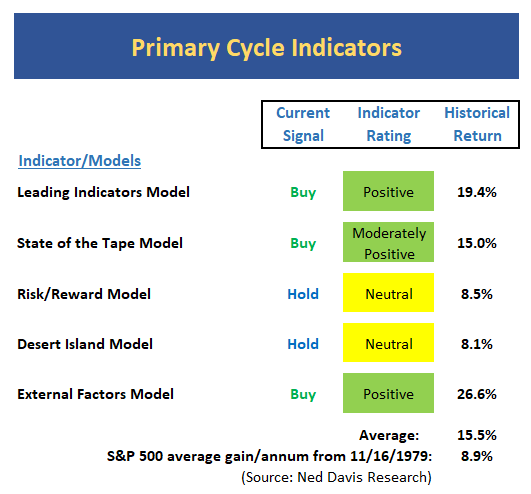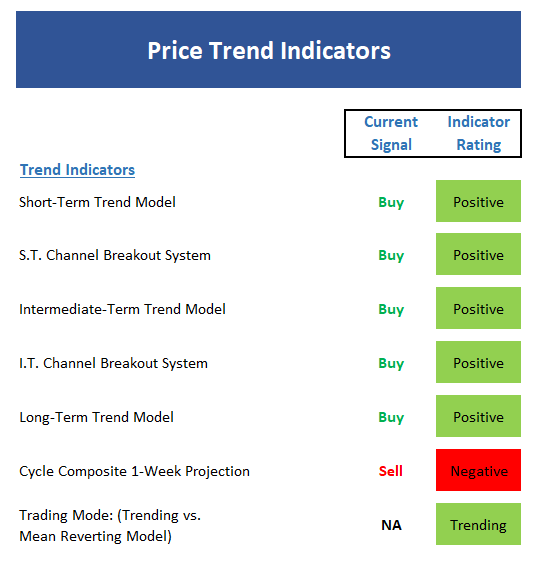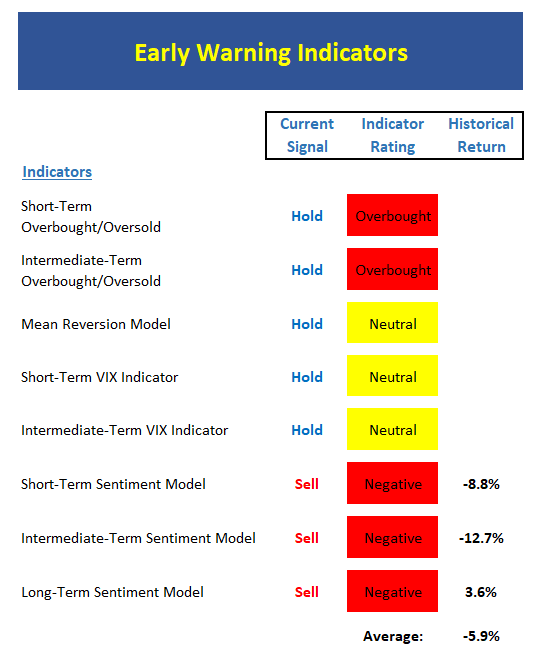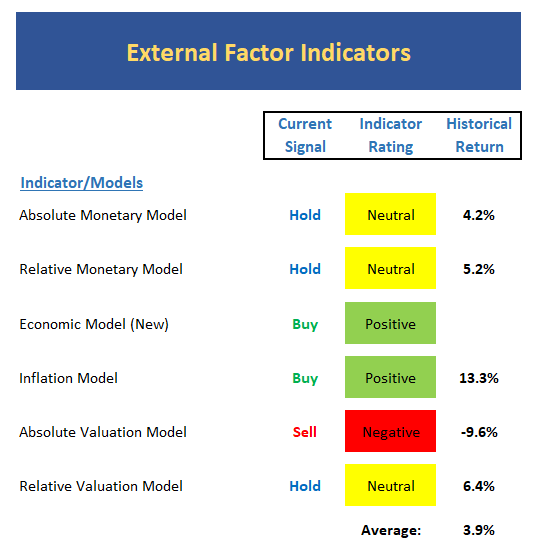Bulls On The Run
The "State of the Markets"
With the S&P 500 up 2.6% so far in 2018, it appears that, barring an unforeseen disaster today, the market will wind up with a gain for the first five trading days of the new year. And as the saying goes, "As the first five days of the year go, so goes the month." From there, another famous Wall Street-ism suggests, "As January goes, so goes the year."
So, using these clichés as our guide, unless the bears can really find something to get excited about in the next 6.5 hours, it would appear that investors can position portfolios long the stock market and call it good for the year, right!
In my humble opinion, what we are seeing here is a classic melt-up. It's a new year and with the macro factors (economy, inflation, rates, fed, earnings, valuation) still favoring stocks, anyone positioning accounts for the long-term appears to be putting money to work. And this is part of the reason that January tends to be one of the best months of the year in the stock market.
However, it is important to note that (a) trees don't grow to the sky, (b) valuations matter, eventually, and (c) the current move is starting to look a bit parabolic (i.e. the current rate of ascent is unsustainable). As such, the odds would favor some sort of a pullback, corrective phase, or, at the very least, a pause in the joyride to the upside in the near-term.
Yet, technicians have been saying this for months now and the bulls have simply refused to yield. My take is there has been simply too much upside "discounting" of the tax bill's benefits to allow a decline of even 2%.
So, when does this run for the roses end? In my experience, these types of moves last longer than imaginable, especially if you find yourself siding with the bears. And since I don't believe in making predictions, I won't even fathom a guess as to when the bulls decide to take a break. But from a macro point of view, if the current melt-up continues, valuation metrics may begin to attract some attention - especially if the next earnings parade fails to live up to increasingly positive expectations.
So, the bottom line for me will be the state of the earnings season, which will get started in a couple weeks. Until then, "Party on Wayne" may be the best approach.
The State of the Big-Picture Market Models
It's a new week, so let's start things off with a review of the state of the market - I.E. a review my favorite big-picture market models, which are designed to tell us which team is in control of the prevailing major trend.

View My Favorite Market Models Online
Executive Summary:
- The Leading Indicators model, which was our best performing timing model during the last cycle, is holding steady with a reading of 80%.
- We have recently upgraded our "State of the tape" model to include an additional 5 indicator readings. The current reading of the new model has pulled back a bit but remains in the positive zone.
- The Risk/Reward model continues to be troubled by monetary and sentiment conditions and remains stuck in neutral. Personally, I see this as an excellent indicator of the overall risk/reward environment.
- If I had to manage money from a desert island and could only use one model, it would be this one - a combination of internal and external factors. Currently, the model remains on a long-term buy signal, however, the model reading slipped back into the neutral zone to start the week - but by the slimmest of margins.
- The newly expanded External Factors model includes a total of 10 indicators ranging from earnings, yields, sentiment, monetary, economic, and volatility. The current model reading is positive - albeit only by a hair.
- Despite the impressive move in the major indices over the past four days, the Primary Cycle models have actually weakend a smidge. But the bottom line is the bulls remain in control of the ball.
The State of the Trend
Digging into the details, I like to start my weekly review with a look at the "state of the trend." These indicators are designed to give us a feel for the overall health of the current short- and intermediate-term trend models.

View Trend Indicator Board Online
Executive Summary:
- The short-term trend of the stock market appears to be in melt-up mode
- Both the short- and intermediate-term Channel Breakout Systems are positive to start the week. From a short-term perspective, a break below 2673 would turn the system negative, the trend stays positive above 2625 from an intermediate-term point of view.
- The intermediate-term Trend Model also sports a bright shade of green here.
- Ditto for the long-term Trend Model. All good.
- The Cycle Composite suggest a modest pullback in the near-term.
- The Trading Mode models confirm the obvious - that stocks are in a trending environment.
- In sum, there just isn't much to complain about here from an trend indicator standpoint.
The State of Internal Momentum
Next up are the momentum indicators, which are designed to tell us whether there is any "oomph" behind the current trend.

View Momentum Indicator Board Online
Executive Summary:
- Both the short- and intermediate-term Trend and Breadth Confirm Models are positive
- Despite the surge in the indices, the Industry Health Model remains only moderately positive.
- The short-term Volume Relationship is positive, but the model is not as strong as you might expect given the blast higher to start the year.
- However, the intermediate-term Volume Relationship is in good shape.
- As you might suspect, the Price Thrust Indicator is positive to start the week.
- However, the Volume Thrust Indicator can't seem to get out of its own way and is stuck in neutral here.
- The Breadth Thrust Indicator moved up into the positive zone last week.
- The message from the momentum board is clear as the bulls are large and in charge at the present time.
The State of the "Trade"
We also focus each week on the "early warning" board, which is designed to indicate when traders might start to "go the other way" -- for a trade.

View Early Warning Indicator Board Online
Executive Summary:
- From a near-term perspective, stocks are overbought. However, given the veracity of the blast, we're going to suggest the current condition does not warrant a sell signal.
- From an intermediate-term view, stocks are also overbought. But again, we view this as a "good overbought" condition.
- The Mean Reversion Model has been out of whack since mid-October and while it is close to issuing a sell signal, the current reading is neutral.
- The short-term VIX indicator issued a timely buy signal to start the week and has now moved back to neutral. A reversal from a closing VIX reading below 8.9 would turn this indicator red.
- While the longer-term VIX Indicator is technically on a buy signal, the current reading of the model is close to a sell. So, we'll call this neutral to start the week.
- The sentiment models agree that complacency is high at the current time, which is a negative input here.
- The early warning board suggests that stocks are overbought, sentiment is too optimistic, and the rally is due for a pause.
The State of the Macro Picture
Now let's move on to the market's "external factors" - the indicators designed to tell us the state of the big-picture market drivers including monetary conditions, the economy, inflation, and valuations.

View External Factors Indicator Board Online
Executive Summary:
- Absolute Monetary conditions haven't changed - the current model reading is dead neutral.
- The Relative Monetary Model improved a bit last week but remains in the neutral zone. Therefore we can argue that stocks no longer enjoy a monetary tailwind.
- Our Economic Model continues to suggest a strong economic growth environment.
- While nearly everyone in the game is looking for inflation to perk up, the Inflation Model continues to suggest a low inflationary pressure environment.
- The Absolute Valuation Model improved a bit last month, however, the reading remains very high and the current rally will likely erase the gains when next month's update comes out.
- Our Relative Valuation Model continues to inch its way to the negative zone but is currently at the low end of neutral at the present time.
Sample Risk Exposure System
Below is an EXAMPLE of how some of above indicators might be used in order to determine exposure to market risk. The approach used here is a "Model of Models" comprised of 10 independent Models. Each model included gives separate buy and sell signals, which affects a percentage of the model's overall exposure to the market.
Trend models control a total 40% of our exposure. The 3 Momentum Models and 3 Environment Models each control 10% of the portfolio's exposure to market risk. The model's "Exposure to Market Risk" reading (at the bottom of the Model) acts as an EXAMPLE of a longer-term guide to exposure to market risk.
In looking at the "bottom line" of this model, my take is that readings over 75% are "positive," readings between 50% and 75% are "moderately positive," and readings below 50% should be viewed as a warning that all is not right with the indicator world.

View Sample Exposure Model Online
The model above is for illustrative and informational purposes only and does not in any way represent any investment recommendation. The model is merely a sample of how indicators can be grouped to create a guide to market exposure based on the inputs from multiple indicators/models.
Thought For The Day:
Happiness can be found in the darkest of times, if one only remembers to turn on the light. -Unknown
Current Market Drivers
We strive to identify the driving forces behind the market action on a daily basis. The thinking is that if we can both identify and understand why stocks are doing what they are doing on a short-term basis; we are not likely to be surprised/blind-sided by a big move. Listed below are what we believe to be the driving forces of the current market (Listed in order of importance).
1. The State of the Economy
2. The State of Fed Policy
3. The State of Earnings Growth
Wishing you green screens and all the best for a great day,
David D. Moenning
Disclosure: At the time of publication, Mr. Moenning held long positions in the following securities mentioned: none.
Note that positions may change at any time.
Indicators Explained
Short-Term Trend-and-Breadth Signal Explained: History shows the most reliable market moves tend to occur when the breadth indices are in gear with the major market averages. When the breadth measures diverge, investors should take note that a trend reversal may be at hand. This indicator incorporates NDR's All-Cap Dollar Weighted Equity Series and A/D Line. From 1998, when the A/D line is above its 5-day smoothing and the All-Cap Equal Weighted Equity Series is above its 25-day smoothing, the equity index has gained at a rate of +32.5% per year. When one of the indicators is above its smoothing, the equity index has gained at a rate of +13.3% per year. And when both are below, the equity index has lost +23.6% per year.
Channel Breakout System Explained: The short-term and intermediate-term Channel Breakout Systems are modified versions of the Donchian Channel indicator. According to Wikipedia, "The Donchian channel is an indicator used in market trading developed by Richard Donchian. It is formed by taking the highest high and the lowest low of the last n periods. The area between the high and the low is the channel for the period chosen."
Intermediate-Term Trend-and-Breadth Signal Explained: This indicator incorporates NDR's All-Cap Dollar Weighted Equity Series and A/D Line. From 1998, when the A/D line is above its 45-day smoothing and the All-Cap Equal Weighted Equity Series is above its 45-day smoothing, the equity index has gained at a rate of +17.6% per year. When one of the indicators is above its smoothing, the equity index has gained at a rate of +6.5% per year. And when both are below, the equity index has lost -1.3% per year.
Industry Health Model Explained: Designed to provide a reading on the technical health of the overall market, Big Mo Tape takes the technical temperature of more than 100 industry sectors each week. Looking back to early 1980, when the model is rated as "positive," the S&P has averaged returns in excess of 23% per year. When the model carries a "neutral" reading, the S&P has returned over 11% per year. But when the model is rated "negative," stocks fall by more than -13% a year on average.
Cycle Composite Projections: The cycle composite combines the 1-year Seasonal, 4-year Presidential, and 10-year Decennial cycles. The indicator reading shown uses the cycle projection for the upcoming week.
Trading Mode Indicator: This indicator attempts to identify whether the current trading environment is "trending" or "mean reverting." The indicator takes the composite reading of the Efficiency Ratio, the Average Correlation Coefficient, and Trend Strength models.
Volume Relationship Models: These models review the relationship between "supply" and "demand" volume over the short- and intermediate-term time frames.
Price Thrust Model Explained: This indicator measures the 3-day rate of change of the Value Line Composite relative to the standard deviation of the 30-day average. When the Value Line's 3-day rate of change have moved above 0.5 standard deviation of the 30-day average ROC, a "thrust" occurs and since 2000, the Value Line Composite has gained ground at a rate of +20.6% per year. When the indicator is below 0.5 standard deviation of the 30-day, the Value Line has lost ground at a rate of -10.0% per year. And when neutral, the Value Line has gained at a rate of +5.9% per year.
Volume Thrust Model Explained: This indicator uses NASDAQ volume data to indicate bullish and bearish conditions for the NASDAQ Composite Index. The indicator plots the ratio of the 10-day total of NASDAQ daily advancing volume (i.e., the total volume traded in stocks which rose in price each day) to the 10-day total of daily declining volume (volume traded in stocks which fell each day). This ratio indicates when advancing stocks are attracting the majority of the volume (readings above 1.0) and when declining stocks are seeing the heaviest trading (readings below 1.0). This indicator thus supports the case that a rising market supported by heavier volume in the advancing issues tends to be the most bullish condition, while a declining market with downside volume dominating confirms bearish conditions. When in a positive mode, the NASDAQ Composite has gained at a rate of +38.3% per year, When neutral, the NASDAQ has gained at a rate of +13.3% per year. And when negative, the NASDAQ has lost at a rate of -8.5% per year.
Breadth Thrust Model Explained: This indicator uses the number of NASDAQ-listed stocks advancing and declining to indicate bullish or bearish breadth conditions for the NASDAQ Composite. The indicator plots the ratio of the 10-day total of the number of stocks rising on the NASDAQ each day to the 10-day total of the number of stocks declining each day. Using 10-day totals smooths the random daily fluctuations and gives indications on an intermediate-term basis. As expected, the NASDAQ Composite performs much better when the 10-day A/D ratio is high (strong breadth) and worse when the indicator is in its lower mode (weak breadth). The most bullish conditions for the NASDAQ when the 10-day A/D indicator is not only high, but has recently posted an extreme high reading and thus indicated a thrust of upside momentum. Bearish conditions are confirmed when the indicator is low and has recently signaled a downside breadth thrust. In positive mode, the NASDAQ has gained at a rate of +22.1% per year since 1981. In a neutral mode, the NASDAQ has gained at a rate of +14.5% per year. And when in a negative mode, the NASDAQ has lost at a rate of -6.4% per year.
Short-Term Overbought/sold Indicator: This indicator is the current reading of the 14,1,3 stochastic oscillator. When the oscillator is above 80 and the %K is above the %D, the indicator gives an overbought reading. Conversely, when the oscillator is below 20 and %K is below its %D, the indicator is oversold.
Intermediate-Term Overbought/sold Indicator: This indicator is a 40-day RSI reading. When above 57.5, the indicator is considered overbought and when below 45 it is oversold.
Mean Reversion Model: This is a diffusion model consisting of five indicators that can produce buy and sell signals based on overbought/sold conditions.
VIX Indicator: This indicator looks at the current reading of the VIX relative to standard deviation bands. When the indicator reaches an extreme reading in either direction, it is an indication that a market trend could reverse in the near-term.
Short-Term Sentiment Indicator: This is a model-of-models composed of 18 independent sentiment indicators designed to indicate when market sentiment has reached an extreme from a short-term perspective. Historical analysis indicates that the stock market's best gains come after an environment has become extremely negative from a sentiment standpoint. Conversely, when sentiment becomes extremely positive, market returns have been subpar.
Intermediate-Term Sentiment Indicator: This is a model-of-models composed of 7 independent sentiment indicators designed to indicate when market sentiment has reached an extreme from an intermediate-term perspective. Historical analysis indicates that the stock market's best gains come after an environment has become extremely negative from a sentiment standpoint. Conversely, when sentiment becomes extremely positive, market returns have been subpar.
Long-Term Sentiment Indicator: This is a model-of-models composed of 6 independent sentiment indicators designed to indicate when market sentiment has reached an extreme from a long-term perspective. Historical analysis indicates that the stock market's best gains come after an environment has become extremely negative from a sentiment standpoint. Conversely, when sentiment becomes extremely positive, market returns have been subpar.
Absolute Monetary Model Explained: The popular cliché, "Don't fight the Fed" is really a testament to the profound impact that interest rates and Fed policy have on the market. It is a proven fact that monetary conditions are one of the most powerful influences on the direction of stock prices. The Absolute Monetary Model looks at the current level of interest rates relative to historical levels and Fed policy.
Relative Monetary Model Explained: The "relative" monetary model looks at monetary indicators relative to recent levels as well as rates of change and Fed Policy.
Economic Model Explained: During the middle of bull and bear markets, understanding the overall health of the economy and how it impacts the stock market is one of the few truly logical aspects of the stock market. When our Economic model sports a "positive" reading, history (beginning in 1965) shows that stocks enjoy returns in excess of 21% per year. Yet, when the model's reading falls into the "negative" zone, the S&P has lost nearly -25% per year. However, it is vital to understand that there are times when good economic news is actually bad for stocks and vice versa. Thus, the Economic model can help investors stay in tune with where we are in the overall economic cycle.
Inflation Model Explained: They say that "the tape tells all." However, one of the best "big picture" indicators of what the market is expected to do next is inflation. Simply put, since 1962, when the model indicates that inflationary pressures are strong, stocks have lost ground. Yet, when inflationary pressures are low, the S&P 500 has gained ground at a rate in excess of 13%. The bottom line is inflation is one of the primary drivers of stock market returns.
Valuation Model Explained: If you want to get analysts really riled up, you need only to begin a discussion of market valuation. While the question of whether stocks are overvalued or undervalued appears to be a simple one, the subject is extremely complex. To simplify the subject dramatically, investors must first determine if they should focus on relative valuation (which include the current level of interest rates) or absolute valuation measures (the more traditional readings of Price/Earnings, Price/Dividend, and Price/Book Value). We believe that it is important to recognize that environments change. And as such, the market's focus and corresponding view of valuations are likely to change as well. Thus, we depend on our Valuation Models to help us keep our eye on the ball.
Disclosures
The opinions and forecasts expressed herein are those of Mr. David Moenning and may not actually come to pass. Mr. Moenning's opinions and viewpoints regarding the future of the markets should not be construed as recommendations. The analysis and information in this report is for informational purposes only. No part of the material presented in this report is intended as an investment recommendation or investment advice. Neither the information nor any opinion expressed constitutes a solicitation to purchase or sell securities or any investment program.
Any investment decisions must in all cases be made by the reader or by his or her investment adviser. Do NOT ever purchase any security without doing sufficient research. There is no guarantee that the investment objectives outlined will actually come to pass. All opinions expressed herein are subject to change without notice. Neither the editor, employees, nor any of their affiliates shall have any liability for any loss sustained by anyone who has relied on the information provided.
Mr. Moenning may at times have positions in the securities referred to and may make purchases or sales of these securities while publications are in circulation. Positions may change at any time.
The analysis provided is based on both technical and fundamental research and is provided "as is" without warranty of any kind, either expressed or implied. Although the information contained is derived from sources which are believed to be reliable, they cannot be guaranteed.
Investments in equities carry an inherent element of risk including the potential for significant loss of principal. Past performance is not an indication of future results.
